 |
 |
 |
| |
Assessment of Virological Response at Week 4 and at Week 12 Optimizes Prediction of Treatment Outcome in Patients With Chronic Hepatitis C Treated With Peginterferon alfa-2b Plus Ribavirin
|
| |
| |
Reported by Jules Levin
AASLD, Nov -6, 2007, Boston, MA
Michelle Martinot-Peignoux,1 Sarah Maylin,1 Marie-Pierre Ripault,2 Rami Moucari,2 Nathalie Boyer,2 Nathalie Giuily,2 Corinne Castelnau,2 Patrick Marcellin1,2
1INSERM U-773, Centre de Recherche Biomedicale Bichat-Beaujon CRB3, Universite Paris VII; 2Service d'Hepatologie, Hopital Beaujon, Clichy, France
Conclusions
⋅ Undetectable serum HCV RNA at week 4 (RVR), when assessed with a sensitive assay such as TMA, is more accurate in predicting SVR (96%-100%) than a baseline viral load cutoff of ≦400,000 IU/mL (27%-76%), both in treatment-naive and treatment-experienced patients
⋅ The absence of EVR at week 12 (<2 log10 decrease in HCV RNA from baseline) is a strong predictor (96%-100%) of nonresponse to therapy regardless of pretreatment status
⋅ Monitoring of patients during therapy with PEG-IFN plus RBV should include
- Qualitative detection of serum HCV RNA at week 4 to predict SVR
- Quantification of serum HCV RNA at treatment initiation and week 12 to predict non-SVR (no EVR and no SVR)
⋅ In all patient groups, the PPV of undetectable HCV RNA at week 4 was 96% to 100%
⋅ Failure to attain virologic response at week 12 of therapy was strongly associated with failure to attain SVR
- The NPV of detectable HCV RNA at week 12 was 76% to 90%
- The NPV of <2 log10 decrease in HCV RNA from baseline at week 12 was 96% to 100%
Abstract
Pretreatment viral load is an important predictor for treatment outcome in patients with chronic hepatitis C. Recently, Zeuzem et al (AASLD 2006) proposed 400,000 IU/mL (assessed with the COBAS TaQMan HCV assay) as the optimal cutoff to best discriminate low and high VL, based on the probability to achieve SVR in patients treated with peginterferon (PEG-IFN) alfa 2a + ribavirin (RBV).
Aims: Our study aimed to analyze the positive predictive value (PPV) of this cutoff value at baseline, the PPV of rapid virological response at week 4 (RVR4) and the negative predictive value (NPV) of non early virological response at week 12 (non-EVR12), in patients treated with PEG-IFN alfa 2b + RBV.
Methods: 408 patients (221 naive; 187 non-naive) consecutively treated with PEG-IFN alfa-2b+RBV (PEG IFN 1.5 _g/kg/week, plus RIBA 800-1200 mg/day according to weight), were included in this study. Patients with genotypes 1, 4 or 5 or non-responders were treated 48 weeks; naive patients infected with genotypes 2 or 3 were treated 24 weeks. Serum HCV RNA was measured at baseline, week 4, week 12, end of treatment and 6 months after the end of treatment with the quantitative VERSANT HCV 3.0 Assay (bDNA) (Siemens Medical Solution Diagnostics). Samples below the limit of quantification were tested with VERSANT HCV RNA Qualitative Assay (TMA) (Siemens Medical Solution Diagnostic). SVR was defined as undetectable serum HCV RNA by
TMA at end of 6 months' post-treatment follow-up.
At treatment initiation, PPV was defined with a cutoff set up at ≦400 - 10-3rd IU/mL; at week 4 the PPV was defined as TMA undetectable or ≥2 log10 drop in baseline viral load; at week 12 the NPV was defined as TMA detectable or <2 log10 drop in baseline viral load.
Results: The overall SVR rate was 46% (53% in naive patients and 38% in non-naive patients).
Conclusions:Undetectable HCV RNA at week 4 (RVR) when assessed with a sensitive assay (TMA) is more accurate (96%-100%) than baseline cutoff (≦400 _ 103 IU/mL) to predict SVR both in naive and in experienced patients. The absence of EVR at week 12 (less than 2 log10 reduction of HCV RNA) is a strong predictor (96%-100%) of nonresponse to therapy, independent of the patients pretreatment status.
Definitions
⋅ Pretreatment viral load
- Low: ≦400,000 IU/mL
- High: >400,000 IU/mL
⋅ RVR: TMA undetectable (<10 IU/mL) or a ≥2 log10 drop in viral load from baseline at week 4
⋅ Non-EVR: TMA detectable or <2 log10 drop in viral load from baseline at week 12
⋅ SVR: undetectable serum HCV RNA by TMA at the end of follow-up
⋅ PPV: number of patients who attained SVR or the number of patients identified by the model initial viral load ≦400,000 IU/mL;
undetectable [<10 IU/mL] HCV RNA at week 4
⋅ NPV: number of patients who did not attain SVR or the number of patients identified by the model initial viral load
>400,000 IU/mL; <2 log10 drop in HCV RNA from baseline at week 12
Virologic Response Rates
⋅ The overall SVR rate was 46% (Figure 1)
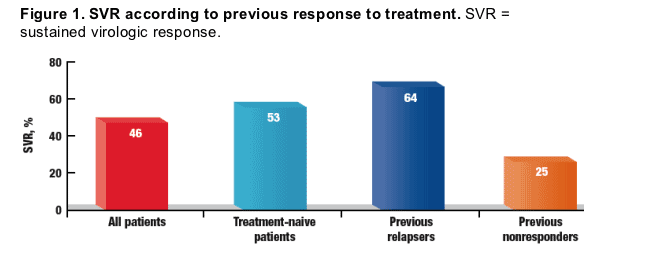
Predictors of Response
Baseline Viral Load (Figure 2)
⋅ The PPV for initial viral load of ≦400,000 IU/mL ranged from 27% to 76%
⋅ The NPV for initial viral load of >400,000 IU/mL ranged from 45% to 77%
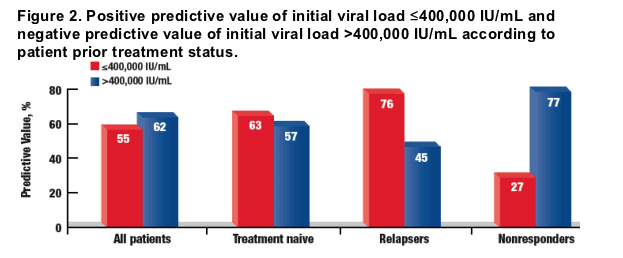
Week 4 Virologic Response (Figure 3)
⋅ In all patient groups, the PPV of undetectable HCV RNA at week 4 was 96% to 100%
⋅ A ≥2 log10 decrease in HCV RNA from baseline yielded less predictive power; PPV values ranged from 50% to 78%
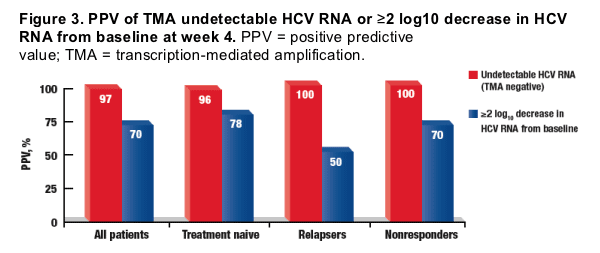
Week 12 Virologic Response (Figure 4)
⋅ Failure to attain virologic response at week 12 of therapy was strongly associated with failure to attain SVR
- The NPV of detectable HCV RNA at week 12 was 76% to 90%
- The NPV of <2 log10 decrease in HCV RNA from baseline at week 12 was 96% to 100%
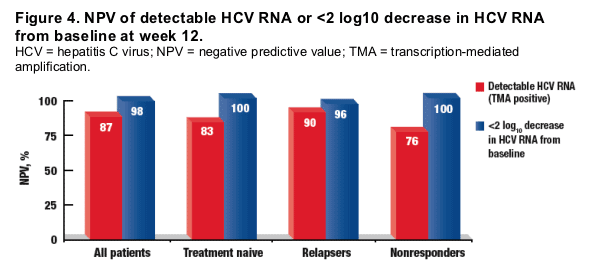
SVR According to Virologic Response During Therapy
⋅ SVR according to virologic response during therapy is shown in Figure 5
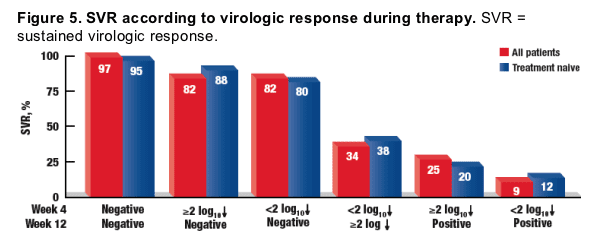
Reference
1. Zeuzem S et al. Hepatology 2006;44:267A.
|
| |
|
 |
 |
|
|